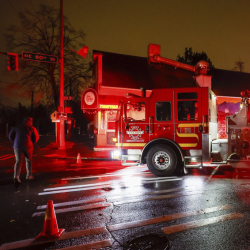 It has been more than a decade since the first US drone strike in Pakistan, and can we say that we are safer for it? In recent years, the drone campaign has expanded from Yemen to Pakistan, Somalia, eastern Turkey and the southern Philippines. Has the violence in these regions lessened and hatred of America abated?
It has been more than a decade since the first US drone strike in Pakistan, and can we say that we are safer for it? In recent years, the drone campaign has expanded from Yemen to Pakistan, Somalia, eastern Turkey and the southern Philippines. Has the violence in these regions lessened and hatred of America abated?
The answer is a resounding no. The near daily attacks in Pakistan, Yemen and other areas where the war on terror is being played out, and countless lives lost — feeding into high-levels of anti-Americanism — are the clearest signals that the drone has failed.
Not only is it a fact that innocent people are killed in drone strikes — confirmed by no less an authority than President Obama himself in his recent speech at the National Defense University — but the drone is an ineffective weapon in the fight against terrorism. It creates more enemies than it eliminates and worsens the violence in the targeted regions.
US drones do not operate in a vacuum. They are being introduced into tribal societies, which are already in turmoil. Many of these societies have been locked in conflict with their central governments for decades. It was only after 9-11 that the US, in its newly minted war on terror, allied itself with central governments that were quick to ascribe the actions of the periphery to the evil machinations of al-Qaida and other Islamic terrorists. The US quickly came swooping in with its drones, exacerbating the conflict between center and periphery, and arousing the anger of the nation at large.
For every "militant" killed, there is a long line of other misguided young men ready to take his place, seeking revenge for the trauma caused to their society. For every drone strike, the Tehrik-e-Taliban Pakistan has vowed to take revenge with a suicide bombing. A tribesman from Waziristan told me that there are not enough bombs in the region to fill the demand from willing suicide bombers.
Beyond the Tribal Areas, the drone campaign has stoked bitter resentment from the Pakistani nation as a whole, souring relations with a key ally in the region needed more than ever during the impending US withdrawal from Afghanistan. Several major candidates in the recent Pakistani elections, including the new Prime Minister Nawaz Sharif , made opposition to US drone strikes a central part of their campaigns.
Regardless of any of the perceived merits of the drones — with many supporters lauding the precision of the weapon or the ability to keep American boots off the ground — the use of the drone is a clear sign that the US is not understanding the source of the violence in these regions and therefore unable to target the underlying cause.
As a former administrator of tribal societies in both the Tribal Areas and Baluchistan in Pakistan, I found it necessary to rely upon political measures working within existing tribal structures to check violent elements within society rather than relying on force alone. Stability in these regions has traditionally been maintained through the councils of elders and traditional religious leaders acting as mediators working with the representative of the central government.
Unfortunately, these pillars of authority have been damaged or demolished in recent years amid the broader turmoil in the region. Groups like the TTP have filled that vacuum. The traditional pillars need to be reconstructed and supported in order to effectively check the men of violence.
The only means to bring peace to the region is through long-term political solutions. For anyone who understands tribal society, the use of military force, including the drone, only escalates the problem rather than solving it and represents a failure of the political administration. Simply put, the drone is an ineffective method of fighting terrorism.
Akbar Ahmed is the Ibn Khaldun Chair of Islamic Studies at American University in Washington, DC and author of "The Thistle and the Drone: How America's War on Terror Became a Global War on Tribal Islam."
Portland and Seattle
Free Subscription to Breaking News
Free Subscription to Breaking News


















































































































































































































































































































































